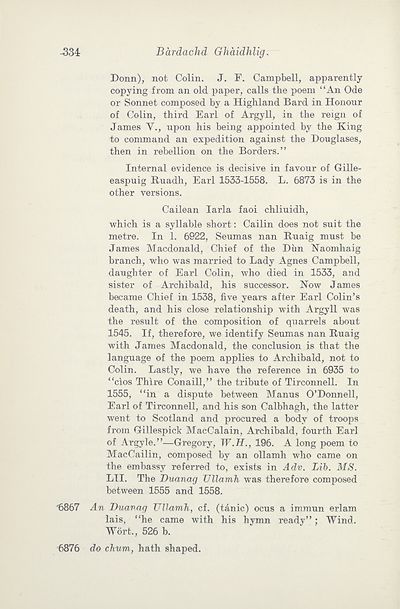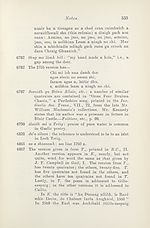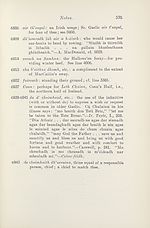Download files
Complete book:
Individual page:
Thumbnail gallery: Grid view | List view

■534
Bardachd Ghaidhlig.
Bonn), not Colin. J. F. Campbell, apparently
copying from an old paper, calls the poem “An Ode
or Sonnet composed by a Highland Bard in Honour
of Colin, third Earl of Argyll, in the reign of
James V., upon his being appointed by the King
to command an expedition against the Douglases,
then in rebellion on the Borders.”
Internal evidence is decisive in favour of Gille-
easpuig Ruadh, Earl 1533-1558. L. 6873 is in the
other versions.
Cailean larla faoi chliuidh,
which is a syllable short: Cailin does not suit the
metre. In 1. 6922, Seumas nan Ruaig must be
James Macdonald, Chief of the Dim Naomhaig
branch, who was married to Lady Agnes Campbell,
daughter of Earl Colin, who died in 1533, and
sister of Archibald, his successor. Now James
became Chief in 1538, five years after Earl Colin’s
death, and his close relationship with Argyll was
the result of the composition of quarrels about
1545. If, therefore, we identify Seumas nan Ruaig
with James Macdonald, the conclusion is that the
language of the poem applies to Archibald, not to
Colin. Lastly, we have the reference in 6935 to
“cios Thire Conaill,” the tribute of Tirconnell. In
1555, “in a dispute between Manus O’Donnell,
Earl of Tirconnell, and his son Calbhagh, the latter
went to Scotland and procured a body of troops
from Gillespick MacCalain, Archibald, fourth Earl
of Argyle.”—Gregory, W.H., 196. A long poem to
MacCailin, composed by an ollamh who came on
the embassy referred to, exists in Adv. Lib. MS.
LIE The Duanag Ullamh was therefore composed
between 1555 and 1558.
•6867 An Duanag Ullamh, cf. (tanic) ocus a immun erlam
lais, “he came with his hymn ready”; Wind.
Wort., 526 b.
6876 do chum, hath shaped.
Bardachd Ghaidhlig.
Bonn), not Colin. J. F. Campbell, apparently
copying from an old paper, calls the poem “An Ode
or Sonnet composed by a Highland Bard in Honour
of Colin, third Earl of Argyll, in the reign of
James V., upon his being appointed by the King
to command an expedition against the Douglases,
then in rebellion on the Borders.”
Internal evidence is decisive in favour of Gille-
easpuig Ruadh, Earl 1533-1558. L. 6873 is in the
other versions.
Cailean larla faoi chliuidh,
which is a syllable short: Cailin does not suit the
metre. In 1. 6922, Seumas nan Ruaig must be
James Macdonald, Chief of the Dim Naomhaig
branch, who was married to Lady Agnes Campbell,
daughter of Earl Colin, who died in 1533, and
sister of Archibald, his successor. Now James
became Chief in 1538, five years after Earl Colin’s
death, and his close relationship with Argyll was
the result of the composition of quarrels about
1545. If, therefore, we identify Seumas nan Ruaig
with James Macdonald, the conclusion is that the
language of the poem applies to Archibald, not to
Colin. Lastly, we have the reference in 6935 to
“cios Thire Conaill,” the tribute of Tirconnell. In
1555, “in a dispute between Manus O’Donnell,
Earl of Tirconnell, and his son Calbhagh, the latter
went to Scotland and procured a body of troops
from Gillespick MacCalain, Archibald, fourth Earl
of Argyle.”—Gregory, W.H., 196. A long poem to
MacCailin, composed by an ollamh who came on
the embassy referred to, exists in Adv. Lib. MS.
LIE The Duanag Ullamh was therefore composed
between 1555 and 1558.
•6867 An Duanag Ullamh, cf. (tanic) ocus a immun erlam
lais, “he came with his hymn ready”; Wind.
Wort., 526 b.
6876 do chum, hath shaped.
Set display mode to:
![]() Universal Viewer |
Universal Viewer | ![]() Mirador |
Large image | Transcription
Mirador |
Large image | Transcription
| An Comunn Gàidhealach > An Comunn Gàidhealach Publications > Bardachd Ghaidhlig > (402) |
|---|
| Permanent URL | https://digital.nls.uk/126285956 |
|---|
| Description | This contains items published by An Comunn, which are not specifically Mòd-related. It includes journals, annual reports and corporate documents, policy statements, educational resources and published plays and literature. It is arranged alphabetically by title. |
|---|
| Description | A collection of over 400 items published by An Comunn Gàidhealach, the organisation which promotes Gaelic language and culture and organises the Royal National Mòd. Dating from 1891 up to the present day, the collection includes journals and newspapers, annual reports, educational materials, national Mòd programmes, published Mòd literature and music. |
|---|---|
| Additional NLS resources: |
|

